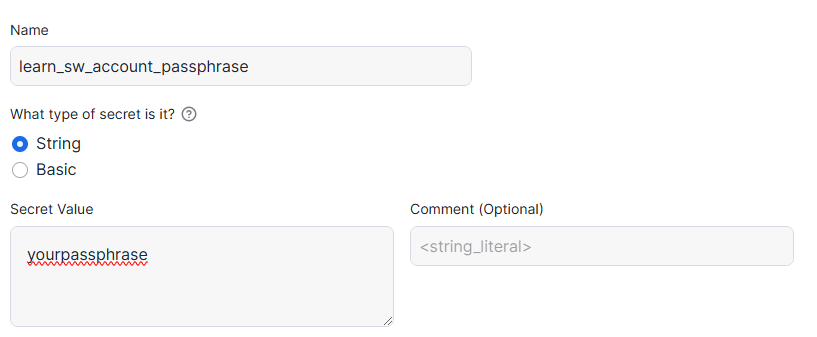Tutorial: Create and Use an SSH & SFTP Connection
This tutorial provides step-by-step instructions for using an SSH and SFTP connection, enabling you to execute remote commands and transfer files between local and remote systems.
Prerequisites
Before continuing with this tutorial, ensure you have completed the following prerequisites:
A remote server with SSH or SFTP connectivity available
A valid user account with appropriate access credentials for the remote server
Create a secret for the user account
Access the Snoweaver SSH application with the owner role or a custom role with the SNOWEAVER_SSH.APP_ADMIN application role.
Open the Secrets page from the side bar menu.
Create a new secret with the following configuration:
Name: learn_sw_account Secret Type: Basic Username: <your user account> Password: <your private key or password>

Save the new secret.
If your private key is protected by a passphrase, create an additional secret with the passphrase:
Name: learn_sw_account_passphrase Secret Type: String Secret Value: <your passphrase>

Create a network rule to access the server
Create an External Integration to Establish SSH Connectivity
Open the External Integrations page.
Apply the following configuration:
Name: learn_sw_access_integration Allowed Secrets: learn_sw_account learn_sw_account_passphrase Allowed Network Rules: learn_sw_access_rule
Click Generate Script to create an SQL script for creating a new External Access Integration and granting Snoweaver the necessary access permissions.
Run the script in a Snowflake worksheet. The role used for execution must have the CREATE INTEGRATION privilege. For instance, use the AccountAdmin role.

Note
Currently, Snowflake does not support native applications requesting permissions to create integrations on consumer accounts. This step may be automated in the future should this restriction be lifted.
Return to Snoweaver and register the new external access integraiton.

Create a new connection
Open the Connections page.
Apply the following configuration:
Name: learn_sw Host: <address of your SSH server> Port: (Optional) <SSH port if it is not 22> Authentication Type: <Password or Key> Key Type: <Password or Key> Account Secret: learn_sw_account External Access Integration: learn_sw_access_integration Passphrase Secret: (Optional) learn_sw_account_passphrase

Save the connection.
Execute SSH Commands Using the Connection
Open a Snowflake worksheet and execute the following SQL statements using a role with the necessary privileges. If you are working in a sandbox environment, you may use the AccountAdmin role or an equivalent role:
CREATE WAREHOUSE IF NOT EXISTS LEARN_SW_WH WAREHOUSE_SIZE = XSMALL AUTO_SUSPEND = 60 COMMENT = 'Warehouse for Snoweaver SSH learning project'; -- Create a developer role with specific permissions CREATE ROLE IF NOT EXISTS LEARN_SW_DEVELOPER; GRANT USAGE ON WAREHOUSE LEARN_SW_WH TO ROLE LEARN_SW_DEVELOPER; -- Grant Snoweaver SSH operator application role GRANT APPLICATION ROLE SNOWEAVER_SSH.LEARN_SW_OPERATOR TO ROLE LEARN_SW_DEVELOPER; -- Assign the developer role to the user account GRANT ROLE LEARN_SW_DEVELOPER TO USER <Your User Account>; -- Set context to the developer role and LEARN_SW schema USE ROLE LEARN_SW_DEVELOPER; USE SCHEMA SNOWEAVER_SSH.LEARN_SW; -- generate a sample file in DATA CREATE OR REPLACE TEMPORARY TABLE ACCOUNTS AS SELECT '789' AS customExtIdField__c, 'Grand Hotels & Resorts Ltd' AS name,10000 AS NumberOfEmployees UNION SELECT '890','Express Logistics and Transport',5000 UNION SELECT '901','University of Arizona',1000; COPY INTO @DATA/accounts.csv.gz FROM ACCOUNTS FILE_FORMAT = (TYPE = CSV COMPRESSION = GZIP FIELD_OPTIONALLY_ENCLOSED_BY='"') HEADER=TRUE OVERWRITE = TRUE SINGLE = TRUE ;
Execute the following SQL statements to verify the SSH connectivity:
USE ROLE LEARN_SW_DEVELOPER; USE SCHEMA SNOWEAVER_SSH.LEARN_SW; -- Verify SSH connection by checking the current directory SELECT SSH('pwd') AS current_directory; -- Test result handling WITH SSH_TEST AS ( SELECT SSH('foo') AS result ) SELECT result:success::boolean AS command_success, result:data::text AS command_output FROM SSH_TEST;
Transfer Files Using SFTP
Open a Snowflake worksheet and execute the following SQL statements:
USE ROLE LEARN_SW_DEVELOPER; USE SCHEMA SNOWEAVER_SSH.LEARN_SW; -- Upload with default settings CALL UPLOAD('accounts.csv.gz', 'learn_sw/accounts.csv.gz'); -- Upload with decompression enabled and two parallel threads CALL UPLOAD( file_path => 'accounts.csv.gz', remote_file_path => 'learn_sw/accounts.csv', decompress => TRUE, parallel => 2); -- Download with default settings CALL DOWNLOAD('learn_sw/accounts.csv', 'learn_sw/accounts.csv'); -- Download with compression disabled, overwrite enabled, and two parallel threads CALL DOWNLOAD( remote_file_path => 'learn_sw/accounts.csv', file_path => 'learn_sw/accounts.csv', compress => FALSE, overwrite => TRUE, parallel => 2);
Verify the transferred files in the remote directory and the DATA stage by executing the following SQL commands:
-- List files in the remote directory SELECT SSH('ls -l learn_sw'):data::text; -- List files in the DATA stage LIST @DATA;
